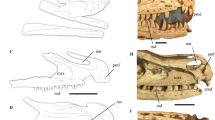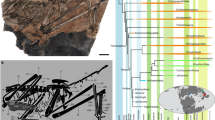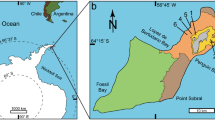Abstract
Non-avian dinosaurs are mostly medium to large-sized animals, and to date all known mature specimens are larger than the most primitive bird, Archaeopteryx1. Here we report on a new dromaeosaurid dinosaur, Microraptor zhaoianus gen. et sp. nov., from the Early Cretaceous Jiufotang Formation of Liaoning, China2. This is the first mature non-avian dinosaur to be found that is smaller than Archaeopteryx1, and it eliminates the size disparity between the earliest birds and their closest non-avian theropod relatives. The more bird-like teeth, the Rahonavis -like ischium and the small number of caudal vertebrae of Microraptor are unique among dromaeosaurids and improve our understanding of the morphological transition to birds. The nearly completely articulated foot shows features, such as distally positioned digit I, slender and recurved pedal claws, and elongated penultimate phalanges, that are comparable to those of arboreal birds3,4,5,6. The discovery of these in non-avian theropods provides new insights for studying the palaeoecology of some bird-like theropod dinosaurs.
This is a preview of subscription content, access via your institution
Access options
Subscribe to this journal
Receive 51 print issues and online access
$199.00 per year
only $3.90 per issue
Buy this article
- Purchase on Springer Link
- Instant access to full article PDF
Prices may be subject to local taxes which are calculated during checkout





Similar content being viewed by others
References
Sereno, P. C. The evolution of dinosaurs. Science 284, 2137–2147 (1999).
Jin, F. New advances in the late Mesozoic stratigraphic research of western Liaoning, China. Vertebrata PalAsiatica 34, 102– 122 (1996).
Yaden, D. W. in The Beginnings of Birds (eds Hecht, M. K., Ostrom, J. H., Viohl, G. & Wellnhofer, P.) 91–97 (Freunde des Jura-Museums Eichstatt, Eichstatt, 1985).
Yalden, D. W. Climbing Archaeopteryx. Archaeopteryx 15, 107–108 (1997).
Ostrom, J. H. The cursorial origin of avian flight. Mem. Calif. Acad. Sci. 8, 73–81 (1986).
Feduccia, A. Evidence from claw geometry indicating arboreal habits of Archaeopteryx . Science 259, 790– 793 (1993).
Xu, X. & Wang, X.-L. New psittacosaur (Ornithischia, Ceratopsia) occurrence from the Yixian Formation of Liaoning, China and its stratigraphical significance. Vertebrata PalAsiatica 36, 147–158 (1998).
Wellnhofer, P. Ein neues Exemplar von Archaeopteryx. Archaeopteryx 6, 1–30 (1988).
Xu, X., Wang, X.-L. & Wu, X.-C. A dromaeosaurid dinosaur with a filamentous integument from the Yixian Formation of China. Nature 401, 262–266 (1999).
Russell, D. A. & Dong, Z.-M. A nearly complete skeleton of a new troodontid dinosaur from the Early Cretaceous of the Ordos Basin, Inner Mongolia, People's Republic of China. Can. J. Earth Sci. 30, 2163–2173 ( 1994).
Currie, P. J. Bird-like characteristics of the jaws and teeth of troodontid theropods (Dinosauria, Saurischia). J. Vert. Paleont. 7, 72– 81 (1987).
Clark, J. M., Perle, M. & Norell, M. A. The skull of Erlicosaurus andrewsi, a Late Cretaceous “Segnosaur” (Theropoda: Therizinosauridae from Mongolia). Am. Mus. Novit. 3115, 1–39 (1994).
Ostrom, J. H. Osteology of Deinonychus antirrhopus, an unusual theropod dinosaur from the Lower Cretaceous of Montana. Peabody Mus. Nat. Hist. Bull. 30, 1–165 ( 1969).
Wellnhofer, P. Das siebte Exemplar von Archaeopteryx aus den Solnhofener Schichten. Archaeopteryx 11, 1–47 (1993).
Currie, P. J. New information on the anatomy and relationships of Dromaeosaurus albertensis (Dinosauria: Theropoda). J. Vert. Paleont. 15, 576–591 (1995).
Martin, L. D. in Origins of the Higher Groups of Tetrapods (eds Schultze, H.-P. & Trueb, L.) 485–540 (Comstock, Ithaca and London, 1991).
Zhou, Z. & Martin, L. D. Feathered dinosaur or bird?—a new look at the hand of Archaeopteryx. Smithson. Contrib. Paleobiol. 89, 289–293 ( 1999).
Forster, C. A., Sampson, S. D., Chiappe, L. M. & Krause, D. W. The theropod ancestry of birds: new evidence from the Late Cretaceous of Madagascar. Science 279, 1915–1919 (1998).
Makovicky, P. & Sues, H.-D. Anatomy and phylogenetic relationships of the theropod dinosaur Microvenator celer from the Lower Cretaceous of Montana. Am. Mus. Novit. 3240, 1– 27 (1998).
Holtz, T. R. Jr . The phylogenetic position of the Tyrannosauridae: implications for theropod systematics. J. Paleont. 68, 1100– 1117 (1994).
Norell, M. A. & Makovicky, P. J. Important features of the dromaeosaur skeleton: information from a new specimen. Am. Mus. Novit. 3215, 1–28 (1997).
Currie, P. J. & Peng, J.-H. A juvenile specimen of Saurornithoides mongoliensis from the Upper Cretaceous of northern China. Can. J. Earth Sci. 30, 2224–2230 (1994).
Currie, P. J., Rigby, J. K. & Sloan, R. E. in Dinosaur Systematics: Perspectives and Approaches (eds Carpenter, K. & Currie, P. J.) 108– 125 (Cambridge Univ. Press, Cambridge, 1990).
Wellnhofer, P. A. A new specimen of Archaeopteryx from the Solnhofen Limestone. Nat. Hist. Mus. Los. Angeles County Sci. Ser. 36, 3 –23 (1992).
Zhou, Z.-H. & Hou, L.-H. Confuciusornis and the early evolution of birds. Vertebrata PalAsiatica 36(2), 136–146 (1998).
Buffetaut, E., Suteethorn, V. & Tong, H.-Y. The earliest know tyrannosaur from the Lower Cretaceous of Thailand. Nature 381, 689– 691 (1996).
Xu, X., Tang, Z.-L. & Wang, X.-L. A therizinosaurid dinosaur with integumentary structures from China. Nature 399, 350– 354 (1999).
Clark, J. M., Hopson, J. A., Hernandez, R., Fastovsky, D. E. & Montellano, M. Foot posture in a primitive pterosaur. Nature 391, 886–889 (1998).
Chiappe, L. M. Climbing Archaeopteryx? A response to Yalden. Archaeopteryx 15, 109–112 ( 1997).
Chatterjee, S. The Rise of Birds (John Hopkins Univ. Press, Baltimore, 1997).
Acknowledgements
We thank D. Unwin, L. Chiappe, X.-C. Wu, J. Clark and L. Witmer for comments; M.-M. Chang and Y.-Q. Wang for assistance during the course of the work; H.-J. Wang for preparing the specimen; R.-S. Li for making the drawings; and J. Zhang and H.-L. You for taking the photographs. This work was supported by the Special Funds for Major State Basic Research Projects of China, and research grants from the National Geographic Society of the United States, Chinese Natural Science Foundation, and the Chinese Academy of Sciences.
Author information
Authors and Affiliations
Corresponding author
Supplementary information
Rights and permissions
About this article
Cite this article
Xu, X., Zhou, Z. & Wang, X. The smallest known non-avian theropod dinosaur. Nature 408, 705–708 (2000). https://doi.org/10.1038/35047056
Received:
Accepted:
Issue Date:
DOI: https://doi.org/10.1038/35047056
This article is cited by
-
Intestinal preservation in a birdlike dinosaur supports conservatism in digestive canal evolution among theropods
Scientific Reports (2022)
-
Longest-surviving Carboniferous-family insect found in Mesozoic amber
Biologia (2022)
-
Molecular phyloecology suggests a trophic shift concurrent with the evolution of the first birds
Communications Biology (2021)
-
Ultramicrostructural reductions in teeth: implications for dietary transition from non-avian dinosaurs to birds
BMC Evolutionary Biology (2020)
-
New Dromaeosaurid Dinosaur (Theropoda, Dromaeosauridae) from New Mexico and Biodiversity of Dromaeosaurids at the end of the Cretaceous
Scientific Reports (2020)
Comments
By submitting a comment you agree to abide by our Terms and Community Guidelines. If you find something abusive or that does not comply with our terms or guidelines please flag it as inappropriate.



